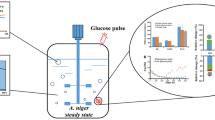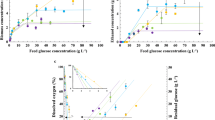Abstract
The behavior of Streptomyces peucetius var. caesius N47 was studied in a glucose limited chemostat with a complex cultivation medium. The steady-state study yielded the characteristic constants μ max over 0.10 h−1, Y XS 0.536 g g−1, and mS 0.54 mg g−1 h−1. The product of secondary metabolism, ɛ-rhodomycinone, was produced with characteristics Y PX 12.99 mg g−1 and m P 1.20 mg g−1 h−1. Significant correlations were found for phosphate and glucose consumption with biomass and ɛ-rhodomycinone production. Metabolic flux analysis was conducted to estimate intracellular fluxes at different dilution rates. TCA, PPP, and shikimate pathway fluxes exhibited bigger values with production than with growth. Environmental perturbation experiments with temperature, airflow, and pH changes on a steady-state chemostat implied that an elevation of pH could be the most effective way to shift the cells from growing to producing, as the pH change induced the biggest transient increase to the calculated ɛ-rhodomycinone flux.





Similar content being viewed by others
References
Arcamone F, Cassinelli G, Fantini G, Grein A, Orezzi P, Pol C, Spalla C (1969) Adriamycin, 14-hydroxydaunomycin, a new antitumor antibiotic from S. peucetius var. caesius. Biotechnol Bioeng 11:1101–1110
Avignone Rossa C, White J, Kuiper A, Postma PW, Bibb M, Teixeira de Mattos MJ (2002) Carbon flux distribution in antibiotic-producing chemostat cultures of Streptomyces lividans. Metab Eng 4:138–150
Bencini D, Wild J, O’Donovan G (1983) Linear one-step assay for the determination of orthophosphate. Anal Biochem 132:254–258
Bergter F, Riesenberg D (1982) Morphological and biochemical properties of Streptomyces hygroscopicus grown in chemostat. Folia Microbiol 27:303–307
Borodina I, Schöller C, Eliasson A, Nielsen J (2005a) Metabolic network analysis of Streptomyces tenebrarius, a Streptomyces species with an active Entner–Doudoroff pathway. Appl Environ Microbiol 71:2294–2302
Borodina I, Krabben P, Nielsen J (2005b) Genome-scale analysis of Streptomyces coelicolor A3(2) metabolism. Genome Res 15:820–829
Doran P (1995) Bioprocess engineering principles. Academic, London, UK
Hilliger M, Knorre A, Bergter F (1978) Erhaltungsstoffwechsel in glucoselimitierten chemostatenkulturen von Streptomyces hygroscopicus. Z Allg Mikrobiol 18:39–45
Hoskisson PA, Hobbs G (2005) Continuous culture—making a comeback? Microbiology 151:3153–3159
Hutchinson CR, Colombo AL (1999) Genetic engineering of doxorubicin production in Streptomyces peucetius: a review. J Ind Microbiol Biotechnol 23:647–652
Inoue S, Nishizawa Y, Nagai S (1982) Stimulation of streptomycin formation by Streptomyces griseus grown in a phosphate deficient culture. J Ferment Technol 60: 417–422
James P, Edwards C, Dawson M (1991) The effects of temperature, pH and growth rate on secondary metabolism in Streptomyces thermoviolaceus grown in a chemostat. J Gen Microbiol 137:1715–1720
Jonsbu E, Christensen B, Nielsen J (2001) Changes of in vivo fluxes through central metabolic pathways during the production of nystatin by Streptomyces noursei in batch culture. Appl Microbiol Biotechnol 56:93–100
Kang SG, Lee KJ (1997) Kinetic analysis of morphological differentiation and protease production in Streptomyces albidoflavus SMF301. Microbiology 143:2709–2714
Kantola J, Kunnari T, Mäntsälä P, Ylihonko K (2003) Expanding the scope of aromatic polyketides by combinatorial biosynthesis. Comb Chem High Throughput Screen 6:501–512
Kim H, Smith C, Micklefield J, Mavituna F (2004) Metabolic flux analysis for calcium dependent antibiotic (CDA) production in Streptomyces coelicolor. Metab Eng 6:313–325
Kirk S, Avignone Rossa C, Bushell M (2000) Growth limiting substrate affects antibiotic production and associated metabolic fluxes in Streptomyces clavuligerus. Biotechnol Lett 22:1803–1809
Kiviharju K, Leisola M, Eerikäinen T (2004) Optimization of Streptomyces peucetius var. caesius N47 cultivation and ɛ-rhodomycinone production using experimental designs and response surface methods. J Ind Microbiol Biotechnol 31:475–481
Kretschmer S (1985) Morphogenetic behaviour of two Streptomyces strains analyzed by the use of chemostats. J Basic Microbiol 25:569–574
Kretschmer S (1992) Location of branches within the apical hyphal region of Streptomyces granaticolor mycelia. J Basic Microbiol 32:35–42
Lee SH, Lee KJ (1994) Kinetics of the repression of tylosin biosynthesis by ammonium ion in Streptomyces fradiae. J Biotechnol 32:149–156
Martin JF (2004) Phosphate control of the biosynthesis of antibiotics and other secondary metabolites is mediated by the PhoR–PhoP system: an unfinished story. J Bacteriol 186:5197–5201
Melzoch K, Teixeira de Mattos M, Jeijssel O (1997) Production of actinorhodin by Streptomyces coelicolor A3(2) grown in chemostat culture. Biotechnol Bioeng 54:577–582
Noack D (1986) Directed selection of differentiation mutants of Streptomyces noursei using chemostat cultivation. J Basic Microbiol 26:231–239
Rhodes PM (1984) The production of oxytetracycline in chemostat culture. Biotechnol Bioeng 26:382–385
Riesenberg D, Erdmann A, Bergter F (1979) Distribution functions of variables characterizing the mycelial morphology of Streptomyces hygroscopicus grown in glucose-limited chemostat cultures. Z Allg Mikrobiol 19:481–487
Roth M, Neigenfind M, Bormann EJ, Noack D (1986) Use of chemostat for selection of Streptomyces hygroscopicus mutants altered in regulation of maltose utilization. Biotechnol Lett 8:479–484
Roth M, Neigenfind M, Hänel F, Bormann EJ (1987) Use of chemostat for selection of Streptomyces chrysomallus mutants altered in the induction of d-glucose isomerase. Biotechnol Lett 9:855–860
Segura D, Santana C, Gosh R, Escalante L, Sanchez S (1997) Anthracyclines: isolation of overproducing strains by the selection and genetic recombination of putative regulatory mutants of Streptomyces peucetius var. caesius. Appl Microbiol Biotechnol 48:615–620
Undisz K, Noack D (1993) Autonomous selection of differentiation mutants of Streptomyces lividans TK24 in continuous culture. Biotechnol Lett 15:13–18
Watve M, Tickoo R, Jog M, Bhole B (2001) How many antibiotics are produced by the genus Streptomyces? Arch Microbiol 176:386–390
Weber T, Welzel K, Pelzer S, Vente A, Wohlleben W (2003) Exploiting the genetic potential of polyketide producing streptomycetes. J Biotechnol 106:221–232
Acknowledgements
The authors wish to thank Finnish Funding Agency for Technology and Innovation (TEKES) for funding, and Marjaana Rytelä and Auli Murrola for the HPLC analysis.
Author information
Authors and Affiliations
Corresponding author
Rights and permissions
About this article
Cite this article
Kiviharju, K., Moilanen, U., Leisola, M. et al. A chemostat study of Streptomyces peucetius var. caesius N47. Appl Microbiol Biotechnol 73, 1267–1274 (2007). https://doi.org/10.1007/s00253-006-0607-z
Received:
Revised:
Accepted:
Published:
Issue Date:
DOI: https://doi.org/10.1007/s00253-006-0607-z




